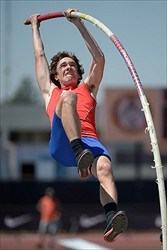HARRISON WILLIAMS: A DECATHLETE'S ADVANTAGE
09/08/2015
Written by: Adele Correale San Miguel Originally posted in Vaulter Magazine by Adele Correale San Miguel When Harrison Williams grabbed a pole as a gangly 15-year old to compete in his first decathlon, no one believed he had the strength to sprint down the runway and haul himself over the bar, ...
 Written by: Adele Correale San Miguel
Written by: Adele Correale San Miguel 
Originally posted in Vaulter Magazine by Adele Correale San Miguel
When Harrison Williams grabbed a pole as a gangly 15-year old to compete in his first decathlon, no one believed he had the strength to sprint down the runway and haul himself over the bar, let alone triumph in the other nine events. He was only running track to stay in shape for his main sport, basketball.
Harrison had never vaulted, nor attempted seven of the ten events that make up the multis. At that meet, Harrison stiff-poled over the opening height to vault 8-11.75.
A few months later, Harrison placed 8th at the AAU Junior Olympic Games, his first national decathlon. Only a few points separated him from 4th place. Instead of grandstanding about being one of the best in the nation, Harrison experienced regret. Had he trained a bit harder, run the 1500 a little faster, he could have finished much higher. He wanted to improve, not for the accolades, but for the intrinsic satisfaction of performing his best. He could do this.
|
|
Fast forward 4 years, Harrison is a true freshman at Stanford, representing the United States at the 2015 Pan Am Juniors in Edmonton, Canada. He takes home the gold, breaks the U.S. junior record with a score of 8,037, and pole vaults in a field of one, his opening height surpassing the last height of the closest competitor. Harrison had been, it seems, a track star masquerading as a basketball player.
Born in Texas, Harrison grew up in Memphis, Tennessee, the son of Jay and Susie Williams. His athleticism runs deep. Harrison’s grandfather, Jess Williams, was Mississippi’s state champion in the 440 meter dash and the 880 meter relay in 1948 and 1949. Jess played baseball for Mississippi State for three years before earning his CPA and serving through accountancy until his death in 2003. Jay was a top 400 meter sprinter and competed in basketball and football in high school; Harrison’s older sister Allie played volleyball for New York University, and his younger sister Julia participates in high school track.
For the Williamses, family is first and encouragement and trust run high. Harrison says he owes much of his achievement to his parents. They provided constant support, as well as poles and spikes. Attending nearly every meet, Jay was up before Harrison making sure the cooler and track bag were packed for every potentiality. Susie always made sure Harrison had a full dinner even when he arrived home from practice hours after the family meal. Jay and Susie insisted that it was up to Harrison to decide if he wanted to take this track thing seriously or not, giving him the freedom to create his own personal vision. Family dynamics played a part. A busy household meant he could not train in all events until he acquired his license to drive himself to practices.
In addition to workouts with Memphis University School coach Bobby Alston, Harrison received jump instruction from then University of Memphis assistant coach, Chrissie Feldman. He vaulted with Kris Whitfield, and trained for the sprints with Hrukti Maat of the Memphis Mustangs. He learned form and technique. Whitfield had a laid-back approach to the vault, never yelling, but guiding with an intuitive sense of what Harrison needed to succeed. Maat’s intensity was a factor in developing mental toughness. He had to want this.
While Harrison has enjoyed excellent coaching, his coaches enjoyed a phenomenal athlete. By the time Harrison graduated high school, he’d become a Tennessee titan of track and field. Among his many accomplishments are the state title in the pole vault in 2013 and 2014. In 2013 he also took the top spot in the decathlon, 300 meter intermediate hurdles, and high jump, placing second in the 110 meter hurdles. The following year as a senior, Harrison won the gold medal in the decathlon, high jump, 300 meter and 110 meter hurdles. He holds the Tennessee state record in the pole vault, decathlon, 300 and 110 meter hurdles and the 4X400 relay. He won the highly regarded Arcadia Invitational decathlon two years running, and the octathlon at New Balance Outdoor Nationals. He took gold at the AAU decathlon in the 15-16 year old category in 2012, and silver amongst the 17-18 year olds at the USATF Junior Olympics with a score of 7,181. He broke the high school decathlon record at the 2014 IAAF World Championships. No longer slow and weak, Harrison finished his high school pole vaulting with a personal best of 16’8”.
While the pole vault is often the Achilles heel for a decathlete, it is Harrison’s trump card.
He has a confidence in the vault that eludes many athletes. Because of his height, 6’5”, and speed, he can get on the big poles. This past outdoor season, he started jumping on a five meter pole.
The vault is the 8th event in the decathlon which usually serves Harrison when he is closing in on the lead, or in need of creating some distance between his score and the next. This advantage is not always a benefit. Harrison is often the only decathlete vaulting over 4.5 meters, meaning he has less time in between jumps to recover and strategize with his Stanford coach, Michael Eskind. At the Pan Am Juniors, Harrison cleared his opening height on his third attempt, while racing against the clock. He warmed up at 4.5 meters, and blew through his pole. Pulling a larger pole out of the bag, he was dismayed to find it untaped. Only one minute remained on the clock, so Harrison prepared to jump on his smaller pole, forgetting he still wore his warm-up gear. Quickly shedding his t-shirt and sweatpants, he started to run just as the clock ran out. A miss. With 3 minutes until the next jump, Harrison quickly taped up the never-been-used pole and jumped. Another miss. At this point Harrison was on national record pace and had a 500 point lead. A third miss would devastate his edge. The crowd stilled and Susie couldn’t watch. Harrison moved his start back 6 inches to account for the anticipated rush of adrenaline and cleared the bar by two feet. He ended up jumping 16-4.75 and scoring 179 points more than the next decathlete. He trusts himself.
Harrison says the hardest parts are the transitions. It is not easy to go from being quick and explosive in the hurdles, to graceful and accurate in the discus ring. While he sometimes wonders what he could achieve if he focused only on one event, he thinks boredom might ensue if he did not have the challenge of the other nine. He has a hyper ability to focus on what is in front of him and shake off his last performance, no matter how well or poorly he did.
About 10% of Harrison’s 20 hours of weekly training is spent vaulting. A typical days starts with a throws session, followed by some technique work in the long jump, high jump, vault, hurdles, or block starts. Running workouts are made up of a series of 250, 200, and 150 meter sprints. Depending on the day, the workout may end with power cleans and bench press.
Harrison appears to be coded with the optimal template of a decathlete. At 180 lbs. he is physically built for success in the grueling 2 day multis. Equally as important, he has the disposition of a champion. He cheers on his competitors and shouts out the wins of other athletes on social media. Quiet away from the track, he is bold and strong on it. Harrison has an earnestness about him that explains the presence he brings to the event. Braggadocio is sometimes a trait of world class athletes, but it is not any part of this young man’s makeup.
The Olympic rings are aligning. While the 2020 games were a realistic target for him a few months ago, Harrison’s score at the NCAA Outdoor Championships qualified him for the 2016 Olympic Trials. Next summer, Harrison will compete alongside Ashton Eaton and Trey Hardee for the chance to represent the U.S. in Rio de Janeiro. Wearing the red, white, and blue bears a sense of solemnity; still, Harrison is a laid-back 19 year-old as delighted by his new puppy as with a new medal.
Harrison’s is a tale of height, speed, and the magic that happens when one accepts their given talent and fearlessly pursues it. Everyone has a gift, but most fail to develop it, forgetting that they thing they are naturally good at and passionate about is their contribution. Harrison has incorporated a genius for track and field into his daily life, becoming the personal vision he set for himself, and inspiring greatness through sport.
 Email
Email Print
Print








